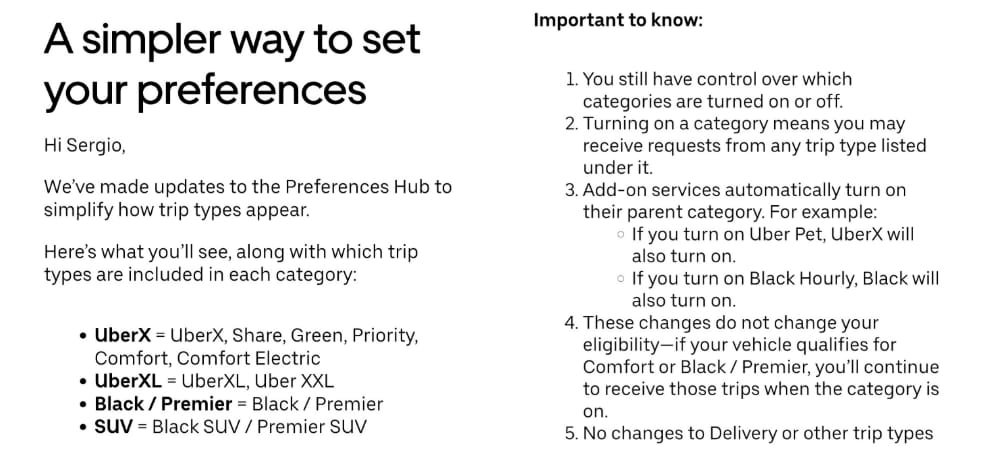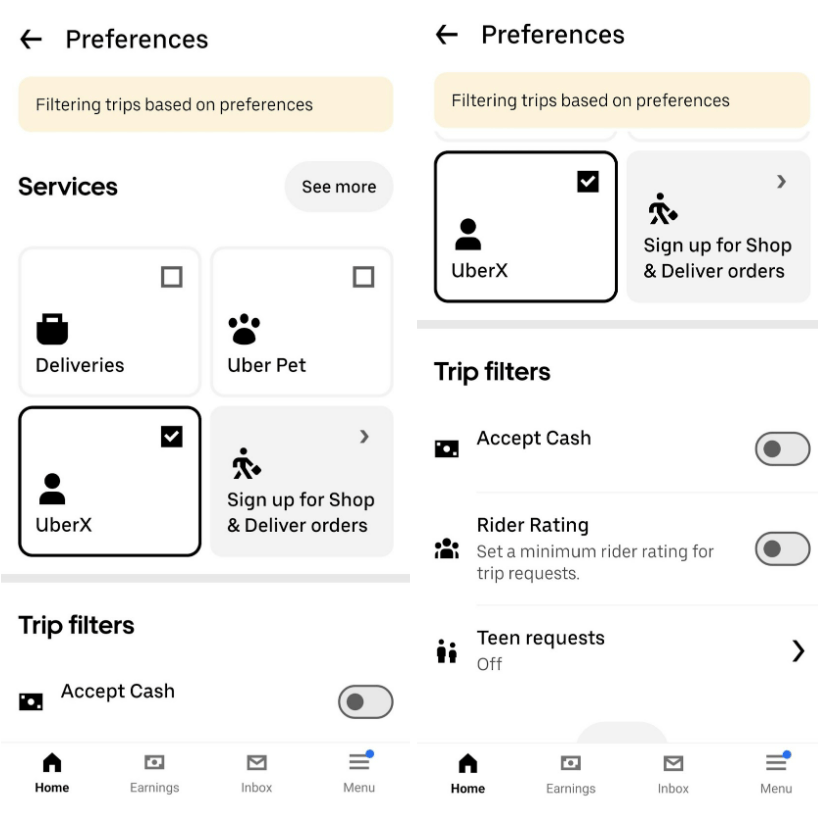- The Rideshare Guy
- Posts
- Uber Takes Away Driver Preferences
Uber Takes Away Driver Preferences
🚗💸 Save While You Drive with Ibotta
Gas, snacks, groceries—your daily driving expenses add up fast. With Ibotta, you’ll earn real cash back on the things you already buy.
Get a $5 bonus when you sign up with our code YRUQMTU

Uber Takes Away Driver Preferences
— By Sergio Avedian —
Ride-hailing platforms like Uber have always walked a delicate balance between algorithmic efficiency and individual flexibility.
For drivers, one of the key appeals of these platforms has been the degree of control they have over when, where, and what kinds of rides they accept. But in recent developments, Uber appears to be pulling back some of those levers, restructuring preference settings in ways that reduce driver choices, while simultaneously introducing new controls for select segments.
The result is a shift in power from drivers toward the platform, raising questions about fairness, autonomy, and transparency.
Historically, Uber’s driver app has included settings that allow drivers (Earners) to express preferences over things like destination filters, driving zones, or “preferred areas,” and certain trip types (such as X, Comfort, or Premium). These preferences allow drivers to optimize their time, reduce deadheading, and avoid undesirable assignments.
The New In-App Driver Preference Settings

Additionally, in many markets, drivers have reported that Uber is removing or consolidating the ability to opt out of specific ride types (e.g., turning off “UberX” or “Uber Share”) without disabling all ride options. For instance, drivers on forums complain that in certain cities, Uber forces them to keep lower-paying ride types (like UberX or Share) toggled on to retain access to premium, higher-paying rides (such as Comfort, UberX Priority).
The net effect: drivers lose granularity in sculpting the kinds of offers they receive.

Why Uber Might Be Retracting Driver Control
What stands behind Uber’s move to curtail driver preferences? Several possible motivations emerge:
Algorithmic Optimization & Throughput
The more constraints drivers impose (destination filters, zone preferences, ride types off), the harder it is for the matching engine to find efficient matches. Removing or limiting preference toggles gives Uber’s dispatch algorithm greater leeway to optimize assignments for reduced wait times, lower dead mileage, and higher utilization.
Fairness / Incentive Alignment
From Uber’s perspective, letting drivers cherry-pick only the “good” trips can create imbalance, unfairness, or externalities for other drivers or the system as a whole. By centralizing control, Uber can enforce more uniform access to ride types and reduce perceived favoritism.
Tiered Rewards & Control by Status
Uber already restricts some advanced features (like Area Preferences) to drivers with higher Pro status levels. This segmentation allows Uber to use preference access as a lever for rewards or compliance, incentivizing drivers to hit certain targets or ratings to regain control.
Brand / Public Relations Features vs. Operational Constraint
Features like Women’s Preferences are also appealing as safety PR moves showing Uber is responding to criticism and making rides safer, even if in practice they only give superficial or limited control to drivers.
The Real Impact on Drivers
From the vantage point of the driver, these changes can sting:
Less Flexibility, More Compulsion
Drivers may find themselves locked into accepting trips they would otherwise reject (e.g., long out-of-the-way drop-offs, or rides outside desired zones). The feeling of being micromanaged by software intensifies.Worsened Earnings Efficiency
If a driver can no longer filter for trips that maximize revenue per minute (or minimize wasted miles), overall hourly yield may decline.Transparency & Consistency Issues
Because Uber’s policies are often rolled out gradually by city or region, some drivers may lose preference toggles while others still retain them, creating confusion, inconsistency, and a sense of arbitrariness.Psychological Belt Tightening
For many drivers, the appeal of gig work was autonomy. When that autonomy is chipped away, the job feels more like a traditional employer-driven role without the protections of employment.
How Drivers Are Responding
On driver forums and social media, the pushback is palpable. Some drivers voice frustration about being forced to leave on low-pay rides in order to be eligible for premium ones. Others note that once preferences are removed or consolidated in their app, they can’t regain them, no matter how long they stayed active. Reddit
In certain communities, drivers are warning newcomers: “Don’t count on being able to opt out of UberX or share — in many places the app hides or disables those toggles.” Reddit
What Should Drivers Watch and Demand?
Demand Transparency
If Uber withdraws toggles or modifies your app’s settings, drivers should ask for changelogs, notice, and rationale. Abrupt removals without explanation erode trust.
Local Advocacy & Collective Organizing
The utility of driver organizations or forums increases when policies change unilaterally. Collective pushback may influence local Uber support teams or negotiations.
Alternate Platforms / Diversification
Don’t put all your eggs in one app. If Uber limits your choices, it may make sense to shift or split time with competing services.
Track Impact / Metrics
Document how preference removal affects key metrics (acceptance rate, idle time, earnings). This data strengthens any challenge or complaint.
Push for Fair Preference Options
If Uber is introducing new toggles, drivers can request parity in other preference options (e.g, destination filtering, ride-type toggling). Drivers should insist that any new feature not come at the expense of existing flexibility.
My Take
Uber’s ongoing recalibration of driver preference settings signals a deeper shift: from a model of platform-as-facilitator to platform-as-controller. While some changes appear responsive to safety concerns, the simultaneous removal of more general toggles erodes the autonomy drivers once enjoyed.
For those who rely on ride-hailing work, the change is not just about app settings; it’s about who holds the levers of control. If drivers lose even small areas of choice day by day, the gig promise of freedom becomes a more constrained routine.
Please send me your comments to [email protected]
Sergio@RSG

Did someone forward you this newsletter? Subscribe now for free so you never miss an update…
Never miss a Rideshare Guy update…